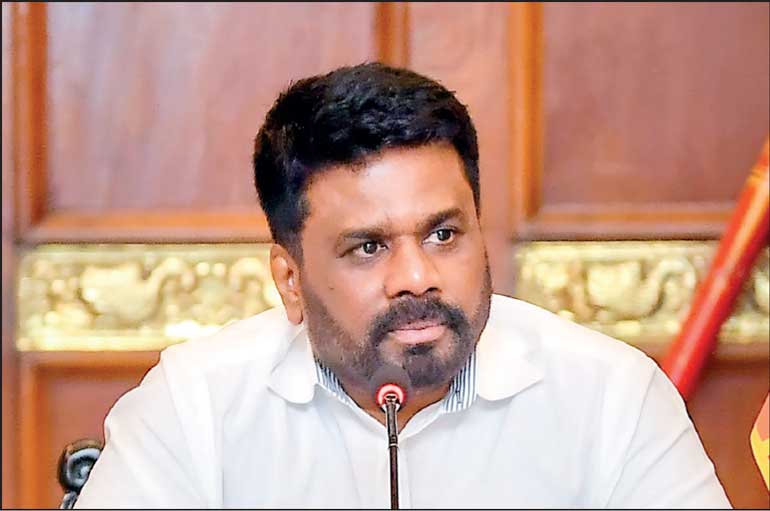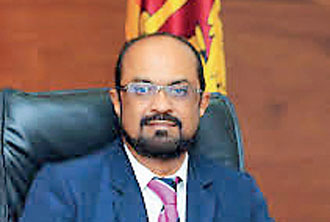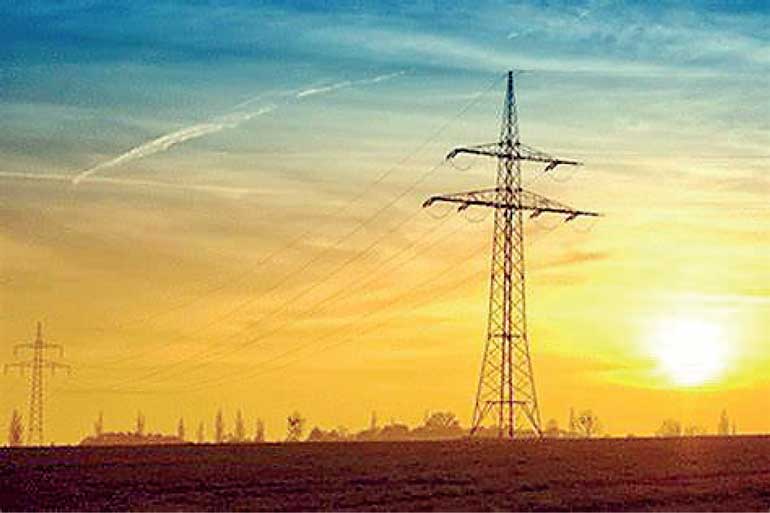Sunday Dec 14, 2025
Sunday Dec 14, 2025
Wednesday, 11 June 2025 00:50 - - {{hitsCtrl.values.hits}}

President Anura Kumara Disanayake
By a Special Correspondent
 |
| Power and Energy Minister (Eng.) Kumara Jayakody |
 |
| If these amendments go through, the electricity in this country would go to the monkeys |
The Government has published Amendments to the Electricity Act No. 30 of 2024, which they plan to approve in the month of June. These amendments reverse some of the main provisions of the original Act to the detriment of the country.
The context of the reform
The electricity sector in Sri Lanka has been run as a State-owned, vertically integrated monopoly with poor efficiency, management practices and technology – that belie investment in it by both Government and funding agencies. The cost of electricity has been significantly high during some years compared to the region, while blackouts have been a regular occurrence spanning the last decade.
While investments have been made, their prioritisation and efficacy remain questionable. While the ADB has pumped millions of dollars into the CEB purportedly to increase the absorption of renewable energy into the grid, the CEB has recently resorted to curtailing renewable energy generation and deterring further additions by imposing non-viable feed-in-tariffs, citing technical challenges that other countries have long since overcome. This is inexcusable, as curtailing energy from the sun and wind will hurt the consumer.
The utility’s finances have been in shambles, and the recent tariff stand-off with the IMF appears to have been triggered by bad accounting practices related to deferred income. State interference in blocking tariff increases resulted in CEB making losses from 2016-2022. The losses and additional capex were funded by debt from DFIs, treasury and state banks – ultimately, the public.
These debts were “repaid” by treasury either infusing equity or converting debt to equity – which happened in 7 out of last 12 years, with the largest in 2022 amounting to a staggering Rs. 450 billion. Now most of CEB’s losses, inefficiencies and wasteful borrowings sit on the Government’s balance sheet, socialising their losses to the public.
When cost-reflective tariffs were introduced after the economic crisis, poor projections by CEB resulted in massive profits on the backs of consumers in 2023 and 2024.
Most countries in the world went through the unbundling of vertical monopoly utilities into separate (multiple) generation entities, transmission, system control and (multiple) distribution entities in the early 2000s. Sri Lanka also embarked on this path in 2003, but this was blocked due to action by CEB’s unions.
During the debt restructuring talks of 2022, SOE reform – primarily CPC, CEB and SriLankan Airlines – were in focus. Most of the reform objectives of CPC were met, and CEB reform objectives were captured in a new Electricity Act legislated nearly 12 months ago. However, this process is now in grave danger of being subverted by the proposed Amendment Bill.
The Electricity Act of 2024
The Electricity Act of 2024 was developed with the input of specialists from many sectors, chambers, professional associations, DFIs, unions and political parties. The three-year process began with a position paper and was guided by experts brought in by the DFIs to support Sri Lanka, who had previous global experience in sector reform, including in India.
The reform was to not merely unbundle CEB, but to set the stage for modern, dynamic and market driven architecture for the sector, supported by strong analytics-based policy formulation and independent regulation. The objectives of the Act include,
a. inclusive, coherent, sustainable policy formulation;
b. independent and accountable corporate entities, with performance-based cultures, with oversight through the Companies Act and Securities and Exchange Commission rules;
c. fair market competition in the generation, distribution and grid services;
d. strong independent regulation by minimising undue political interference and/or corruption;
e. accelerating Renewable Energy deployment leveraging decreasing cost of renewable energy generation and storage to meet national climate targets;
f. creating an environment to attract local and foreign private sector investments;
g. self-sustainability of the electricity sector without a treasury burden
h. to ensure the energy security of the country
The elements of the Electricity Act of 2024
The Electricity Act of 2024 envisaged CEB generation units to be unbundled into four specialised successor companies (hydro, coal, oil and renewable energy), the four distribution divisions of CEB to be unbundled into four independent successor companies (alongside LECO), a national transmission network company to operate the national grid, a national system operator (NSO) tasked with planning, procuring, and dispatching power, and companies to hold legacy functions like the CEB pension fund and shared services. The Act also envisages the establishment of wholesale/retail energy markets, and a market for system services such as storage and grid stability elements.
The policy advisory role, which has historically been ad-hoc, leading to lack of coherence and consistency, was channelled to a body corporate called National Electricity Advisory Council (NEAC) with permanent staff and cabinet appointed/ex-officio members. This would have given transparency, accountability and rigour for policy while eliminating shadow advisors/deals. This would ensure that the transition to market structures, which may take 5-10 years, will be guided by a process assured of continuity. The Power Sector Reform Secretariat (PSRS) was created to guide the reform process through its various phases.
The Act, passed on 27 June 2024, had two key dates – the enactment date, in which certain provisions became operational, and an Appointed Date, which must come into operation within a year of enactment, when the full Act becomes operational.
Breaking the law
The reform process stalled as soon as the NPP Government came into power, and the staff of the PSRS were sent home, including its head, Dr. Pradeep Perera, an experienced sector specialist from ADB. With it, all activities of the reform process ended up in limbo. The Government broke the law by failing to inform employees which successor companies they would be assigned to by 27 October 2024 as required in the Act and omitted to perform certain other functions essential to the corporatisation, on the basis that “they were planning to make changes to the law in the future”. The PSRS has recently sputtered back to life, staffed exclusively by local electrical engineers, lacking in the diversity of skills and experience needed to usher through a complex corporate restructuring process.
Playing to the gallery
The current amendment began from a Cabinet approved committee and a policy document – which has very poor semblance to the final amendments proposed. The committee composition was itself problematic, as raised by Dr. Harsha de Silva in Parliament, with 9 out of 10 members being electrical engineers (including 7 university lecturers) – whereas a sector reform and corporate restructuring is not related to electrical engineering. Committee included chairmen of CEB and LECO, creating a conflict of interest. Legal/investment specialists, senior civil servants and specialists in restructuring were absent. No global experience of sector reform was present. Anecdotes of those who participated in the limited consultations spoke of the lack of depth and breadth of the committee.
The process appeared to be designed to manage various stakeholder groups including the unions, rather than to address a national need.
Reversing the reform
1. From NEAC to shadow policy formation
A unique provision of the 2024 Act was the creation of the NEAC, a statutory body corporate with a permanent staff and Cabinet-appointed members to advise the Government on policy with analysis. It was structured as a sister organisation to PUCSL. This would have enabled policy coherence and consistency, and recommendations subject to public scrutiny and transparency through the RTI Act. NEAC employees and its board will also be fully accountable to the CIABOC in terms of the new bribery and corruption legislation.
The proposed amendments have replaced the NEAC with an ad-hoc committee appointed by the Minister, centralising power at the hands of political authority, outside the public scrutiny and accountability. Removal of the jurisdiction of CIABOC is telling.
The impact of this is not hypothetical. Under the current government, we saw a rapid reversal of the policy promoting renewable energy. The CEB first cancelled the Net Plus Plus scheme, then began cutting renewable energy during Sundays and holidays, delayed battery storage procurements, and ultimately reduced feed-in-tariffs to make them financially unviable and unbankable – the first Government to openly reduce renewable energy access. These anti-renewable strategies only benefit two parties, one that owns all the private oil powered plants – LTL, and the LNG projects that a few in government wants to push through.
These policy decisions were purportedly made on the advice of the NPP Energy Committee, an entity with no legal standing, nor public visibility to its membership or deliberations. Because of the shadowy nature of their activities, it has been difficult to obtain the underlying analysis driving these actions. The Committee appointed to revise the renewable energy feed-in-tariffs have noted in their report (and outside) that they were pressured to change their findings by the NPP committee members.
This is the type of underhand policy manipulation, lack of transparency and accountability and the rule by shadow groups, that the NEAC was set up to prevent.
2. Removing least cost from dispatch
Each day, the CEB system control centre determines a timetable in 15-minute intervals, detailing which power plant should generate how much electricity (day-ahead dispatch). This is based on set rules; first, it cannot compromise system stability, second, it should give the least expensive (least cost) daily generation, third, long-term effective use of hydro reservoir storage. Historically, provisions in Electricity Acts have always established the least cost principle, to keep costs to the consumers as low as possible.
The Amendment replaces the least-cost phrase with security constrained economic dispatch. While the security constrained is defined, the meaning of the term “economic cost” in this context is not defined, leaving it open to interpretation. Does this mean the NSO is able to ignore the direct financial cost to the utility? Or that externality costs used in economic analysis must be factored into the dispatch decisions? Such uncertainty will give the system operators bendable rules that will inevitably lead to higher electricity costs to consumers and withhold accountability.
Not that CEB has ever had to be accountable to the daily dispatch. The CEB has yet to do a single dispatch audit in its history of existence, while plenty of sub-optimum generation has been seen in the past. With the new provision, conducting dispatch audits in the future will be almost impossible.
3. Eroding regulatory independence
In the 2024 Act, the PUCSL is given the power to set seven different tariffs – including consumer tariffs, renewable energy feed-in-tariffs, generation tariffs for PPAs, Open Access charges, allowed revenues for transmission/distribution licensees, etc. Each of these is complex and technical and must be calculated based on the approved methodologies.
The current Amendments mandate PUCSL’s tariff setting done in consultation with Ministry of Finance, introducing a political interference to an independent technical process. This violates the independence of a regulator and sends the wrong signal to investors and politicians. Lest we forget, the reason CEB ended up in a financial crisis was political meddling in tariff setting.
4. Backtracking on global climate commitments
Sri Lanka pledged to generate 70% of electricity from renewable energy sources and to reach net zero emissions by 2050 in the UN Paris Climate Agreement. This is the cheapest pathway for Sri Lanka, which imports all its fossil fuel needs. CEB made a roadmap for the same, supported by experts such as Dr. Tilak Siyambalapitiya, the ex-CEB Chairman, paid for by ADB. Yet, key officials of the current administration have publicly expressed their disdain for the target.
It is not surprising that the Amendments aim to water down this commitment, changing the word decarbonisation to wishy-washy, nonspecific, “reducing carbon footprint”, diluting the targets.
5. Oligarchies instead of competition
The unbundling of the CEB into 13 companies envisaged in the 2024 Act saw (1) unbundling the CEB generation units into four successor companies based on specialisation – hydro, coal, oil and other renewables, and (2) forming four separate legal entities of the four CEB distribution units, (3) separate companies for NSO, transmission, pensions, shared services and others. The intent was to drive efficiency through specialisation and benchmarked performance, create competition to talent and resources, and to create context for effective regulation. Regulation of multiple smaller entities is more effective than regulation of monopoly structure.
In the Amendments, this is staged, with first phase creating two 100% state owned entities for generation and distribution, keeping the monopolies intact. CEB Engineers Union have been boasting “instead of one CEB, we now get four CEBs” referring to generation company, distribution company, transmission company and the system operator. This structure allows them to retain their strangle-hold on the utility operations.
In the second phase, which comes with the final transfer plan, the generation company and distribution company are further unbundled into an unknown number of successor companies in an arbitrary manner. It is unclear why further time is required to determine the form of these. For generation companies, their specialisation should drive entity formation. It’s even simpler for distribution entities, since CEB holds four distribution licenses issued by the regulator.
Thus, the final unbundling of an SOE created by an Act of Parliament after intense debate in the Supreme Court, has been left to arbitrary administrative action by unelected bureaucrats!
Once the Distribution and Generation companies are further unbundled, the form and function of the generation and distribution companies remain un-defined, creating an unnecessary bureaucratic layer, paid for by consumers.
6. LECO and LTL confusion
In the original transfer plan, the CEB owned shares of LTL and LECO were to be assigned to the treasury, like the other successor companies of the CEB. In the Amendments, harmful changes are made.
LECO, the independent distribution company, has been brought under the newly formed Distribution Company, essentially ‘rebundling’ it to the CEB. LECO is the most advanced and innovative distribution entity, in-part due to its independence from CEB. Now they will be subject to the whims of the new distribution company.
LTL holds Sri Lanka’s largest oil-based generation capacity, along with multiple renewable energy projects amounting to over 1200MW (some under construction). The Amendments remove the restrictions for the transmission company (and NSO) to hold distribution and generation licenses, and place LTL under the transmission company. Moving generation assets to a company that is designed to ONLY focus on transmission makes a mockery of the whole unbundling process and introduces a tremendous conflict of interest. With this logic, why separate transmission and generation in the first place?
This is a perplexing move at first glance, but easily explainable. The CEB Chairman becomes the chairman of the LTL due to its majority ownership, and after unbundling, is a role likely to shift to the transmission company chairman. It is rumoured that an official of the PSRS tasked with engineering these changes is hoping to be thus appointed, making it self-serving to the detriment of the public.
7. Blocking access to private finance
The CEB has significant financing requirements across all its divisions. Transmission upgrades are necessary for renewable energy growth, CEB distribution divisions are severely underfunded leading to power quality issues for consumers, investments are needed to stabilise the grid such as BESS, protection system upgrades, NSO requires advanced software, controls, and security systems. Current underfunding is a result of government’s limits to borrow as a state-owned enterprise. The IMF programme puts limits to State sector borrowing even from ADB and JICA, who have been prodigious lenders previously.
A reform priority was to enable the successor companies to raise funds from the market without sole reliance on the state. This has been constrained in multiple ways.
National Transmission Company minimum state ownership has increased from 51% to 100% forcing it to completely rely on state borrowing. In contrast, the Power Grid Corporation of India, the owner of India’s inter-state transmission system, has 49% of its shares listed in the stock market, and periodically issues bonds to fund expansions.
Keeping the finally unbundled distribution and generation subsidiaries under the distribution and generation companies (rather than treasury ownership) creates another management and control layer, that does help attract private capital. This appears as a poison pill provision.
Thus, the state-owned entities will progressively starve of capital and will suffer degradation of infrastructure and services, making the whole nation poorer.
Conclusion
No bill is perfect, yet the 2024 Act appeared to get most of the elements to help the Sri Lankan electricity sector to blossom in the future. Unfortunately, if these amendments go through, the electricity in this country would go to the monkeys.